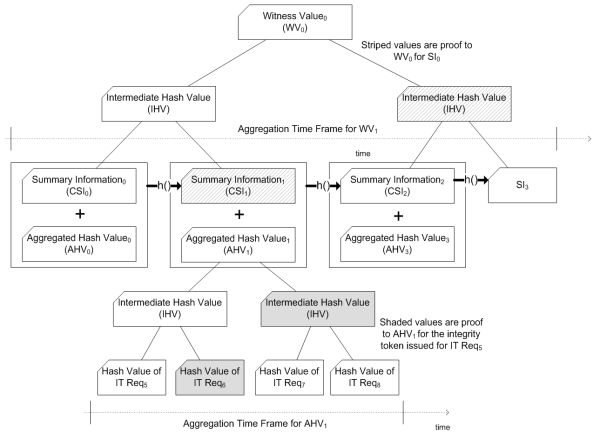Ace:Validating Witness and Tokens: Difference between revisions
From Adapt
No edit summary |
No edit summary |
||
| Line 8: | Line 8: | ||
Tokens are issued to clients after they submit a request. The request contains a hash to secure and a file name. All the hashes for a given time are gathered together and a summary value(CSI) is generated and stored on the IMS. After the round completes and a CSI is generated, clients are given a token that contains enough information to recalculate the CSI for its round. Comparing the recalculated CSI to the CSI stored on the IMS will let clients prove their hashes and tokens are valid. | Tokens are issued to clients after they submit a request. The request contains a hash to secure and a file name. All the hashes for a given time are gathered together and a summary value(CSI) is generated and stored on the IMS. After the round completes and a CSI is generated, clients are given a token that contains enough information to recalculate the CSI for its round. Comparing the recalculated CSI to the CSI stored on the IMS will let clients prove their hashes and tokens are valid. | ||
Here's what happens when a round is closed and a CSI needs to be calculated: | |||
# All the request hashes are set as the leaf nodes in a tree. | |||
# requests are paired together and a sha-256 digest is created for the pair. In the case of an odd number of requests, the last three hashes are paired together. | |||
# The created hashes, Intermediate Hash Value(IHV), are set as the parent nodes for the paired leaf nodes. | |||
# Similar to the previous pairing, IHV's are paired together and a digest is created for the pairs (or last triplet). This new digest is set as parent to the child IHV's. | |||
# The previous step is repeated until only one hash remains at the top of the tree, the Aggregated Hash Value(AHV). | |||
# The new AHV is taken and hashed with the previous CSI to create a new CSI for this round. The new CSI is assigned an ID. | |||
# A token for each request is generated containing the round ID and proof that will allow a client to regenerate the rounds CSI. See below on how to use this proof to reconstruct the CSI | |||
==Validating Tokens and Hashes== | ==Validating Tokens and Hashes== | ||
Revision as of 16:07, 18 September 2008
Overview
ACE offers a two tiered method for ensuring the validity of hashes. The first tier involved calculating a summary value (CSI) for a set of hashes given to the IMS. These CSIs are composed of all hashes for a given time period (round). This CSI can be used to validate any hash submitted during its round. The second tier involves periodically publishing a witness value that is calculated from all CSI values issues during the previous day.

Issuing Tokens
Tokens are issued to clients after they submit a request. The request contains a hash to secure and a file name. All the hashes for a given time are gathered together and a summary value(CSI) is generated and stored on the IMS. After the round completes and a CSI is generated, clients are given a token that contains enough information to recalculate the CSI for its round. Comparing the recalculated CSI to the CSI stored on the IMS will let clients prove their hashes and tokens are valid.
Here's what happens when a round is closed and a CSI needs to be calculated:
- All the request hashes are set as the leaf nodes in a tree.
- requests are paired together and a sha-256 digest is created for the pair. In the case of an odd number of requests, the last three hashes are paired together.
- The created hashes, Intermediate Hash Value(IHV), are set as the parent nodes for the paired leaf nodes.
- Similar to the previous pairing, IHV's are paired together and a digest is created for the pairs (or last triplet). This new digest is set as parent to the child IHV's.
- The previous step is repeated until only one hash remains at the top of the tree, the Aggregated Hash Value(AHV).
- The new AHV is taken and hashed with the previous CSI to create a new CSI for this round. The new CSI is assigned an ID.
- A token for each request is generated containing the round ID and proof that will allow a client to regenerate the rounds CSI. See below on how to use this proof to reconstruct the CSI
Validating Tokens and Hashes
Token Overview
A token contains all information needed to validate a hash. A sample token is shown below:
<?xml version="1.0" encoding="utf-8"?>
<token xmlns="http://umiacs.umd.edu/adapt/ace/token/1.0">
<token-class>SHA-256-0</token-class>
<digest-service>SHA-256</digest-service>
<name>/state/myfile.txt</name>
<round-id>319782</round-id>
<time-stamp>2008-09-16T14:57:27.936-0400</time-stamp>
<proof>
<element index="0">
<hash>7957e058645f953f8e2d11c919414adffab7df12df3e7902eb446b02a40ac908</hash>
</element>
<element index="1">
<hash>9287c2e19f715a67dcb59da8a724084b448dd9382668f347338f1ce20f435872</hash>
</element>
<element index="2">
<hash>e9cc9417014a43e29870f60504cdbe3c49ba9472b4481bb2ff5f7a68cef147bb</hash>
<hash>73384002a2fd512874801fb62e1defbb1902668f04d8a96d6cb90b703d16a506</hash>
</element>
<element index="1">
<hash>d312e4551a3d3ee6d695d96b8851f3ad1574096305f18d4f052fe853bfe14482</hash>
</element>
</proof>
</token>
- token-class:
- digest-service:
- name: name of the file this token refers to. This was supplied by the client in a token request.
- round-id: The ID of the round this token was issued in. This is used to request a CSI from the IMS.
- time-stamp: the timestamp for this round
- proof: tree elements that can be used to locally generate a CSI given a files hash.